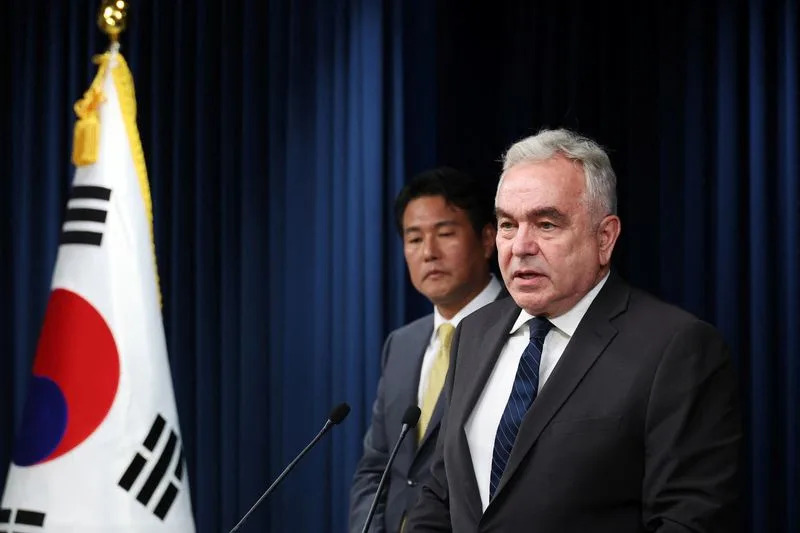US, South Korea to draw up joint nuclear defence guideline against North Korean threat -Yonhap

The United States and South Korea plan to draw up joint guidelines on nuclear defence strategy by the middle of next year and establish an integrated system to deter North Korea's nuclear weapons, Yonhap news agency said on Saturday.
S.Korean, U.S. officials meet for first nuclear planning group with eye on North Korea.
Washington and Seoul have decided to complete a comprehensive guideline by next year on how to contain and respond to Pyongyang's nuclear threat together, Yonhap reported, citing Kim Tae-hyo, South Korea's deputy national security adviser speaking to reporters in the U.S.
The guideline is expected to include methods of sharing sensitive information related to North Korea's nuclear weapons, the consultation process in the event of a nuclear crisis, and real-time communication channels between the two countries' leaders, it said.
The U.S. and South Korea are also expected to include nuclear operation exercises in next year's joint military drills, Yonhap said.
North Korea may test-launch an intercontinental ballistic missile (ICBM) this month, which is a nuclear threat regardless of its range because it can carry a nuclear warhead, Kim had said on Friday.
North Korea has developed and tested a range of ballistic missiles that can reach targets in South Korea, Japan, and the U.S. mainland.
North Korea May Test ICBM This Month to Ramp Up Threat to US.
North Korea may test launch this month a ballistic missile designed to deliver a warhead to the US mainland, a top South Korean security official said, in a show of force by Kim Jong Un as he is set to hold a major policy-setting meeting.
“There is a possibility of North Korea launching an intercontinental ballistic missile in December,” Principal Deputy National Security Adviser Kim Tae-hyo told reporters Thursday when he arrived in the US for a meeting of a bilateral nuclear strategy group.
Kim Tae-hyo did not offer details on any intelligence assessment. But North Korea has launched most of its ICBMs in recent years from a site near Pyongyang’s main international airport that is under close watch by US spy satellites.
By testing an ICBM, the North Korean leader could demonstrate to his top cadres and his people that the country’s nuclear arsenal is making great strides in being able to attack the US, reinforcing the message in propaganda that its expansion is essential to prevent an invasion from American forces.
The last time North Korea tested an ICBM was in July when it fired off its new, solid-fuel Hwasong-18, which had the longest flight time for any of the state’s ballistic missiles. The missile appeared designed to carry a multiple nuclear weapons payload, which increases the chances at least one bomb could slip past interceptors and make its way to a target.
Solid-fuel missiles have the propellants baked into rockets, allowing them to be rolled out and fired in a manner of minutes, giving the US less time to prepare for interception. The challenge becomes even greater if the missile carries several warheads rather than one.
Still, it’s unclear whether the warheads aboard North Korea’s ICBMs could evade interception and survive reentry into the atmosphere to reach their targets.
Kim’s ability to deliver a credible nuclear strike on the US raises the stakes for what must be offered to entice him to wind down his arsenal. But Kim has refused offers from the Biden administration to return to long-stalled disarmament discussions.
South Korea Scrambles Jets as Russia, China Warplanes Near Peninsula.
South Korea scrambled fighter jets after two warplanes from China and four from Russia briefly entered an air identification zone maintained by Seoul, raising tensions on the highly militarized peninsula.
The Russian and Chinese aircraft were in South Korea’s Air Defense Identification Zone from between 11:53 a.m. and 12:10 p.m. on Thursday, Yonhap News agency reported, citing the Joint Chiefs of Staff. The six planes departed the area and did not enter into South Korean airspace, the JCS said, according to Yonhap.
The air zone isn’t South Korea’s territorial air space but is an area where aircraft are supposed to identify themselves as they draw near it. The planes flew above waters between South Korea and Japan, the JCS reportedly said, and were in the general vicinity of an island claimed by Seoul and Tokyo.
When asked about the incident on Thursday, China Foreign Ministry spokeswoman Mao Ning said at a regular press briefing in Beijing that it was “a routine activity” and “it’s in line with international law.”
In June, four warplanes each from Russia and Chinese entered the area known as KADIZ, prompting South Korea to rush its jets into the air.
The flights come as the two Koreas have backed away from a 2018 deal to reduce tensions along their border. After North Korea fired a rocket into space last month that deployed a spy satellite, South Korea restarted surveillance flights it had halted and North Korea threatened action against the aircraft from its neighbor.
Russia has been looking to enlist North Korea in joint military exercises that include China. During a rare trip to Pyongyang in July, Russian Defense Minister Sergei Shoigu proposed to leader Kim Jong Un that they hold joint naval drills that included China, Yonhap reported, citing South Korea’s spy agency.
There is no indication that North Korea accepted the offer. Kim’s state media on Thursday slammed the US, Japan and South Korea for their plan to launch a system this month to share real-time data on missile launches from North Korea, saying the move is pushing the region toward conflict.
- Questions and Answers
- Opinion
- Motivational and Inspiring Story
- Technology
- Live and Let live
- Focus
- Geopolitics
- Military-Arms/Equipment
- الحماية
- Economy
- Beasts of Nations
- Machine Tools-The “Mother Industry”
- Art
- Causes
- Crafts
- Dance
- Drinks
- Film/Movie
- Fitness
- Food
- الألعاب
- Gardening
- Health
- الرئيسية
- Literature
- Music
- Networking
- أخرى
- Party
- Religion
- Shopping
- Sports
- Theater
- Health and Wellness
- News
- Culture



